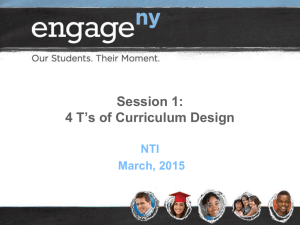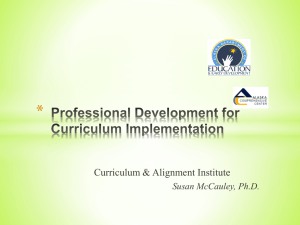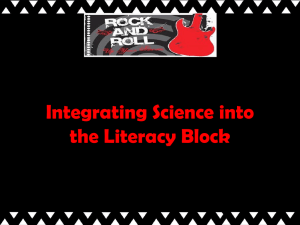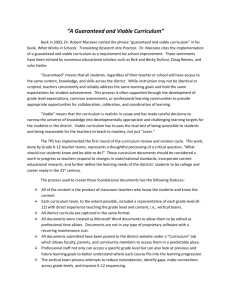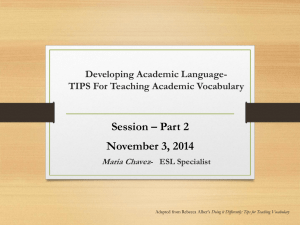The 4 T`s of Expeditionary Learning`s Curriculum
advertisement
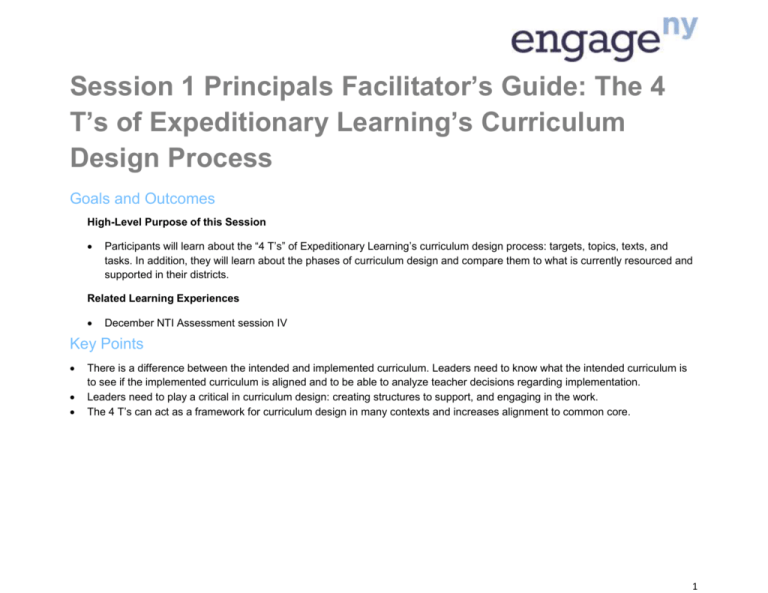
Session 1 Principals Facilitator’s Guide: The 4 T’s of Expeditionary Learning’s Curriculum Design Process Goals and Outcomes High-Level Purpose of this Session Participants will learn about the “4 T’s” of Expeditionary Learning’s curriculum design process: targets, topics, texts, and tasks. In addition, they will learn about the phases of curriculum design and compare them to what is currently resourced and supported in their districts. Related Learning Experiences December NTI Assessment session IV Key Points There is a difference between the intended and implemented curriculum. Leaders need to know what the intended curriculum is to see if the implemented curriculum is aligned and to be able to analyze teacher decisions regarding implementation. Leaders need to play a critical in curriculum design: creating structures to support, and engaging in the work. The 4 T’s can act as a framework for curriculum design in many contexts and increases alignment to common core. 1 Session Outcomes What do we want participants to be able to do as a result of this session? 1. I can explain how the principal’s role in curriculum design impacts student achievement. 2. I can describe the “4Ts” of Common Core-aligned curriculum design. 3. I can describe the phases of curriculum design and compare them to what we currently resource/support. How will we know that they are able to do this? Learning target tracker role play small group discussions Session Overview Section Time Overview Prepared Resources Leader’s role in curriculum design 30 Building a common language: Curriculum quotes.doc curriculum Marshall book review excerpt.pdf Session PPT 4 T’s 50 Introduction to 4 T’s: topic, task, text, targets – and how they provide frame for CC aligned curriculum Facilitator’s Preparation Work through all learning activities employing the lens of a school leader. Download all videos, documents, and powerpoints. Transformational Literacy Excerpt: pgs. 86-93 4 T's note catcher Session PPT Phases of curriculum design 25 Introduction to phases of curriculum design and reflect Curr planning_CBD.pdf Transformational Literacy 2 on current practices Excerpt pgs. 57-71. Learning Target tracker.pdf Session PPT Session Roadmap Section 1: Leader’s Role in Curriculum Design Time Slide #/Pic of Slide 9:45-10:00 1-5 Time: 30 min. Script/Activity directions Grouping Table groups Introduce the basic gist of the two days of PD through sharing a simple agenda with participants. Review the beliefs about adult learning – and how norms support collaborative work. Ask participants to complete the Norms for Collaboration Self-Assessment in their notebook and to set a goal for our time together. Introduce this session’s learning targets through asking participants to do a quick self-assessment on the learning targets: 1. I can explain how the principal’s role in curriculum design impacts student achievement. 2. I can describe the “4Ts” of Common Core-aligned curriculum design. 3 3. I can describe the phases of curriculum design and compare them to what we currently resource/support. 10:0010:10 6-8 In order to build a common language, the facilitator will explore the definition of “curriculum” with participants. Ask participants to turn to a partner and provide the definition of “curriculum”. Then partners switch. Were the definitions the same/different? Share different examples of definitions for curriculum on the slides, and discuss the important of every school community having the same understanding and the same definition of this term. 1. The term curriculum refers to the lessons and academic content taught in a school or in a specific course or program. 2. An individual teacher’s curriculum would be the specific learning standards, lessons, assignments, and materials used to organize and teach a particular course. 3. Overt, explicit or written curriculum is simply that which is written as part of formal instruction of the schooling experience. It may refer to a curriculum document, texts, and supportive materials that are overtly chosen to support the intentional instructional agenda of a school. Point out the term “overt” – ask, what is interesting about that? Share this longer quote on a slide: (this quote and next two are on a handout as well) 4 Curriculum can be envisaged from different perspectives. What societies envisage as important teaching and learning constitutes the "intended" curriculum. Since it is usually presented in official documents, it may be also called the "written" and/or "official" curriculum. However, at classroom level this intended curriculum may be altered through a range of complex classroom interactions, and what is actually delivered can be considered the "implemented" curriculum. What learners really learn (i.e. what can be assessed and can be demonstrated as learning outcomes/learner competencies) constitutes the "achieved" or "learned" curriculum. In addition, curriculum theory points to a "hidden" curriculum (i.e. the unintended development of personal values and beliefs of learners, teachers and communities; unexpected impact of a curriculum; unforeseen aspects of a learning process). Ask: when thinking about these different definitions of curriculum, how might you explain how the role the principal plays in curriculum design impacts student achievement? This transitions participants into the first learning target: 1. I can explain how the principal’s role in curriculum design impacts student achievement. Make the key point that principal engagement in curriculum design is the only way principals can tell the difference between the intended curriculum and the implemented curriculum. Leaders should not assume that one is equal to the other – a school can have an official curriculum, but that has nothing to do with the implemented curriculum. – And, this is not to say that they should be the same. Teachers 5 should adjust, but leaders need to know how those adjustments are aligned or not aligned to the official curriculum. 10:1010:15 9-11 From Marzano’s “What Works”: Chapter 3. A Guaranteed and Viable Curriculum The first school-level factor is a “guaranteed and viable curriculum.” I rank this as the first factor, having the most impact on student achievement. As indicated in Figure 2.3 (p. 19), a guaranteed and viable curriculum is primarily a combination of my factors “opportunity to learn” and “time” (Marzano, 2000a). Both have strong correlations with academic achievement, yet they are so interdependent that they constitute one factor. From Schmoker’s “Focus” What We Teach. This simply means a decent, coherent curriculum, with topics and standards collectively selected by a team of teachers from the school or district—that is actually taught. The number of "power standards" (Ainsworth, 2003a) must not be excessive; it should account for about half of what is contained in our standards documents (Marzano, 2003). This allows us to teach the essential standards in sufficient intellectual depth, with adequate time for deep reading, writing, and talking. Why is this so important? Because such "guaranteed and viable curriculum" (Marzano, 2003, p. 22) is perhaps the most significant school factor that affects learning. But such a curriculum is found in very few schools (Berliner, 1984; Marzano, 2003; Schmidt, 2008). It is for these reasons that we want to engage principals in learning about curriculum design, so that they can ensure 6 there is a guaranteed and viable curriculum in every grade, in every content area in their school. Participants read Marshall’s book review excerpt if there is time. If not, the facilitator can point out resource and offer key insights that support the learning target. Section 2: The 4 T’s Time 10:1510:45 Slide #/Pic of Slide 12-13 Time: 50 min. Script/Activity directions Transition participants into the learning target: I can describe the “4Ts” of Common Core-aligned curriculum design. Participants will read and discuss pgs. 86-93 in Transformational Literacy. (NTI participants will have the actual book, for turn key training, excerpts are provided online) Share the Guiding Question before they begin reading: How do the 4 T’s support students in meeting the Common Core reading and writing standards? Participants should be able to answer this question after reading and discussing with a small group. After reading, participants will have a brief discussion on the following prompts: o What new information did you gain regarding common core aligned literacy curriculum? o What information is relevant to your Grouping Solo/small groups 7 10:4511:05 14-16 school/district and why? How do the 4 T’s support students in meeting the Common Core reading and writing standards? Participants watch and discuss the 4 T’s video (7:17) and use the note-catcher to capture their understanding of each. They may choose to capture new understandings about each component, or draw a visual that represents their understanding of the 4 T’s. Note: the video shows clips from a real school in Rochester where teachers are learning to take their curriculum design to the next level through the 4 T’s framework, as well as a Curriculum Design Intensive, where teachers came together to design the ELA modules. Goal: participants should have a thorough enough understanding of how the 4 T’s operate together to be able to explain it in their own words. Have participants conduct a role-play with a partner. Scenario: You just recently delivered a PD about the 4 T’s to your entire staff – you gave an overview and then dug deeply into “Topic”. A teacher who missed the PD session keeps hearing other staff discussing the “4 T’s” and she is irked that she doesn’t know what they are referring to. She won’t leave your office until she knows what the 4 T’s are. Debrief with the whole group: what are you feeling very clear about, what do you need more information or time to process? 8 Section 2: Phases of Curriculum Design Time 11:0511:15 Slide #/Pic of Slide 16 11:1511:30 17-18 Time: 40 min. Script/Activity directions Grouping Solo; triads Participants will be introduced to “Stages in LongRange Planning…” p.10 Pages 11-13 just provide more details to page 10 and can be skimmed or read later by participants. While reading, participants should consider which of these stages are occurring while teachers are planning curriculum, and most importantly – how do they know? Participants should have small group discussions about where they believe their teachers are in terms of using these stages, and what structures would need to be in place for them to be able to execute each stage effectively. Ask for volunteers to share what those structures would be and consider capturing them on an anchor chart. (5 min) This final discussion will take place after lunch at 12:30 Solo; triads Participants will read and discuss Transformational Literacy pgs. 57-71 before lunch. Questions to address while reading: o Where are your teachers at? How do you know? o What would be the right next step for them? o What professional development do they need and how will you provide it? 9 Turnkey Materials Provided Curriculum quotes.pdf Marshall book review excerpt.pdf 4 T’s note-catcher Curr planning_CBD.pdf Transformational Literacy excerpts: pgs. 86-93, 57-71 Session 1 PowerPoint & Facilitator Guide 10
